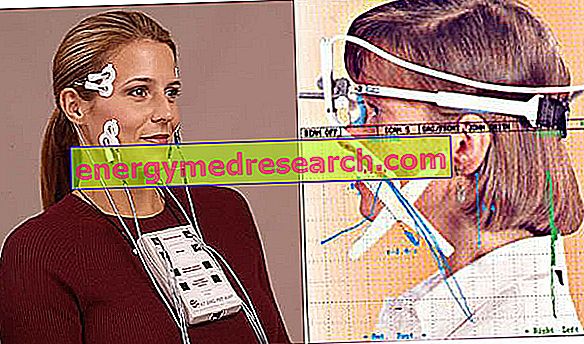By Dr. Andrea Gizdulich and Dr. Francesco Vicenzo
Swallowing, aimed at the ingestion of saliva and alimentary bolus, is the most repetitive act that involves, with its oral phase, the stomatognathic apparatus in all its components. In this phase the masticatory muscles must stabilize the jaw, so as to allow the suprahyoid muscles to raise the hyoid bone, which is decisive for the laryngeal-esophageal peristalsis. Since this act is so iterative, the correct positioning of the tongue from the first stages of deciduous dentition contributes to the appropriate development of the maxillary bone structures. It follows that the pathologies of swallowing, especially if arising at an early age and maintained until adulthood, can easily determine states of cranio-mandibular disorder (DCM) 1-3 due to anatomical alterations of these structures. The most common atypical form of swallowing is determined by the interposition of the tongue and cheeks between the dental arches, often an expression of the prolonged infantile physiological swallowing, and is difficult to diagnose because it occurs when the lips are closed preventing direct inspection, especially if involves the posterior dental sectors rather than the front teeth.
The suspicion of atypical swallowing, due to the presence of typical dental impressions on the mucous membranes of the tongue and cheeks in correspondence with the latero-posterior dental sectors, has been studied in depth with surface electromyography (sEMG) and mandibular kinesiography (CMS)

Fig 1. Graphic representation of mandibular kinesiography
Fig2 Representation of masticatory SSEM
The simultaneous surface electromyographic evaluation of the muscles of the masticatory apparatus4-6 (Fig1) and the computerized scan of the mandibular movements (Fig. 2) can simultaneously document the muscular workload and the position in which this work moves the jaw. The atypical swallowing with tongue or cheek interposition, in fact, is associated with the evident impossibility to tighten the teeth in maximum intercuspidation and to use a reduced workload of the elevator muscles during the stabilization phase of the jaw to avoid the bite (Fig. .3) In fact, the simultaneous deactivation of the masseter and temporal muscles of the jaw and the activation of only the lowering muscles are observed while opening the mouth to make room for the tongue. The subsequent phase of return to the resting position and the position of intercuspidation demonstrates the good functionality of the elevator muscles in voluntary dental fixation. Then we can observe phenomena of activation of neighboring muscles not normally involved in swallowing, such as the sternocleidomastoids whose participation demonstrates the muscular effort necessary to guarantee the passage of the liquid or of the food bolus.

Fig. 3 atypical swallowing. Electromyographic traces at the top: activity of the anterior fibers of the left temporal muscle (LTA) and right (RTA), of the median fibers of the left masseter muscle (LMM) and right (RMM), of the mastoid head fibers of the left sternocleidomastoid (LTP) and right (RTP) muscle, of the anterior abdominal muscles of the left digastric (LDA) and right muscle (RDA). Kinesiographic traces at the bottom broken down in the three planes of space: mandibular movements on the vertical axis (Ver. ), on the anterior-posterior horizontal axis (AP), on the frontal horizontal axis (Lat).
The clinical value of the instrumental diagnosis of atypical swallowing is increased by the possibility of setting a therapy and monitoring it over time, given that the negative influence that this dysfunction plays on Cranio-Mandibular Disorders is ascertained1.
To perform the test, the patient is asked to maintain the resting position and, on command, to swallow the liquid (saliva or water) previously collected in the mouth; subsequently it makes itself firmly close on the posterior teeth and finally beat repeatedly the teeth between them, so as to identify with certainty the usual centric occlusion of the patient. In the case of atypical swallowing, the strong and clear elevation of the jaw is not detected, and the subsequent stabilization against the upper jaw, which instead is recorded in the passage from the usual resting position to the usual occlusion position. At the same time, elevating and supraiode masticatory muscles are monitored, as well as lateral cervical muscles to verify the muscular synergism associated with swallowing itself.
The evaluation of dental therapy with or without a speech therapy is compared after 3-6 months.

Fig. 4 Control test and 6 months
In the control test a rapid passage is observed from the rest position to that of maximum dental intercuspidation, and the swallowing act is exhausted in 1.8 seconds; the electromyographic traces show a greater but always low electrical activity of the temporal muscles (<20 μV) and a regular activation of the masseters (up to 40 μV, duration 0.8 seconds) and digastrics (up to 60 μV, duration 1 second) ; the sternocleidomastoids (up to 50 μV) are also activated simultaneously. The absence of an adequate stabilization plan of the mandible and the persistence of the activation of the sternocleidomastoid muscles demonstrate only partial remission of the problem.
Conclusions
The diagnostic polygraphic test allows easy and safe instrumental diagnostic confirmation in cases of suspected atypical swallowing. It is believed that mandibular kinesiography alone is already in itself a valid method to intercept the atypical swallowing frameworks, as it is able to reveal finely if the swallowing occurs in disclusion of the dental arches rather than in centric occlusion; it is also hypothesized that even surface electromyography alone, already proposed by other Authors4, 6 as a non-invasive method for studying swallowing, may alone be sufficient to document the atypical swallowing pictures: in fact it clearly highlights the failure to or uncertain activation of thunderstorms and masseters in the moments preceding the activation of digastrics, a phenomenon that is characteristic of atypical swallowing10. However, it is believed that the diagnostic examination that allows a more complete diagnosis of atypical swallowing is, due to the completeness of the objective data it provides, the one that simultaneously uses mandibular kinesiography and surface electromyography for the visualization of a polygraphic tracing like that used by us. The method, simple and non-invasive, allows not only to diagnose the existence of atypical swallowing, but also to monitor the therapeutic process and document any healing.
Bibliography
1. Bergamini M, Massi B, Bonanni A.Atypical Swallowing in Cranio-Mandibular Disorders. Proceedings of IV International Symposium of Dentofacial Development and Function. Bergamo, 1982.
2. Jankelson RR. Neuromuscolar Dental Diagnosis and Treatment. Ishiyaku Euroamerica, Inc. Pubblisher 1990-2005.
3. Bergamini M, Prayer Galletti S. Systematic manifestations of Musculo-Skeletal Disorders related to Masticatory Dysfunction. Anthology of Skull-Mandibular Orthopedics. Coy RE Ed, Collingsville IL, Buchanan 1992; 2: 89-102.
4. McKeown MJ, Torpey CD, Gehm WC. Non-invasive monitoring of functionally distinct muscle activations during swallowing. Clinical Neurophysiology 2002; 113: 354-66.
5. Hiroaka K. Changes in masseter muscle activity associated with swallowing. Journal of Oral Rehabilitation 2004; 31: 963-7.
6. Vaiman M, Eviatar E, Segal S. Surface electromyographic studies of swallowing in normal subjects: a review 440 adults. Report 1. Quantitative data: Timing measures. Otolaryngology - Head and Neck Surgery 2004 Oct; 131 (4): 548-55.
7. Jankelson RR. Scientific rationale for surface electromyography to measure postural tonicity in dental patients. Skull 1990 Jul; 8 (3): 207-9.
8. Jankelson B. Measurement accuracy of the mandibular kinesiograph - a computerized study. Journal of Prosthetic Dentistry 1980 Dec; 44 (6): 656-66.
9. Chan CA. Power of neuromuscular occlusionneuromuscnlar dentistry = physiologic dentistry. Paper presented at the American Academy of Craniofacial Pain 12th Annual Mid-Winter Symposium, Scottsdale, AZ 2004 Jan, 30.
10. Stormer K, Pancherz H. Electromyography of the perioral and masticatory muscles in orthodontic patients with atypical swallowing. Journal of Orofacial Orthopedics 1999; 60 (1): 13-23.



